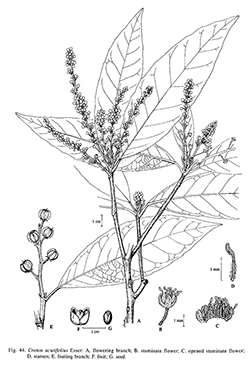e-Flora of Thailand
Volume 8 > Part 1 > Year 2005 > Page 193 > Euphorbiaceae > Croton
1. Croton acutifolius Esserwfo-0000364504
Thai Forest Bull., Bot. 29: 51. 2001. Fig. 44.
Accepted Name : This is currently accepted.
Synonyms & Citations :
Description : Shrub or tree, up to 12 m high, dbh up to 25 cm; bark thick, scaly and roughly vertically cracked, grey-brownish; branchlets slowly glabrescent. Indumentum consisting of stellate, flat to dendritic, yellowish-brown hairs with pale radii (appear creamy-yellowish), 0.2–0.3 mm (on flowers up to 0.5 mm) in diam., with ca 20–25 free radii. Stipules 1–1.5 mm long, densely pubescent. Leaves alternate, often crowded; petiole 1.0–2.5 cm long, densely pubescent, hardly glabrescent; blade elliptic, 12–22 by 4–9.5 cm, index 2.8–3.8, chartaceous, base acute, margin subentire with very shallow and indistinct sertation, apex acute, slightly brighter below, glabrous above, below densely pubescent at the very base and sparsely pubescent on the midrib, otherwise subglabrous with few scattered hairs; basal glands flat, sessile, ca 0.5 mm in diam., lateral on the abaxial midrib base, marginal glands absent; side veins 15–20 pairs, not triplinerved. Inflorescences whitish-green to greyish-green, quite often several in an apical leafless whorl or with immature leaves, each one 8–24 cm long, most often completely staminate, rarely with 3–8 pistillate flowers, sometimes with bisexual bracts; densely and persistently pubescent throughout; bracts 1.5–2 mm long, stiff, persistent, eglandular. Staminate flowers densely pubescent; pedicel 3–5 mm long; sepals 2 by 1 mm; petals 2 by 1 mm, stellate-pubescent outside; stamens ca 10, with filaments often pubescent. Pistillate flowers densely pubescent; pedicel 8–10 mm long (10–13 mm in fruit); sepals 2–3 by 1–1.5 mm, slightly shorter than the ovary, pubescent throughout outside; petals absent or as ca 1 by 0.2 mm, lineal lobes; ovary ca 3 mm long; stigmas 3–4 mm long, not fused at base, undivided for ca 1 mm at base and divided apically. Fruits 6–7 by 8–9 mm, sulcate, densely pubescent and smooth outside. Seeds 6 by 4 mm, with a rudimentary caruncle.
Thailand : NORTHERN: Mae Hong Son (Tham Nam Lot), Chiang Mai (Doi Chiang Dao, Doi Inthanon, Doi Sang, Doi Suthep, Mae Taeng, Mae Rim), Chiang Rai (Doi Luang, Khun Chae, Mae Fa Luang, Mae Suai), Nan (Doi Phu Kha), Lampang (Doi Khuntan; Chae Son – type: Maxwell 96–4, holotype -BKF, isotypes -A CAS CMU L), Phitsanulok (Phu Miang-Phu Thong); NORTH-EASTERN: Phetchabun (Nam Nao).
Distribution : Endemic? To be expected in Laos.
Ecology : In disturbed hill evergreen, evergreen or deciduous seasonal hardwood, hardwood and pine, or mixed evergreen/deciduous forests, secondary thickets, clearings and fire prone places; on lateritic or clayey soil, over granite or limestone; (400–)600–1,400 m alt. Flowering: October–March (August); fruiting: January–April (August). Inflorescences fragrant.
Vernacular : Chi-mi-chi-ya (จิมิจิยา)(Akha-Chiang Rai); mado gai (มะดอไก่)(Red Lahu-Chiang Mai); plao (เปล้า), plao phae (เปล้าแพะ)(Northern).
Uses: The leaves, in mixture with other plants, are used for cuts.
Notes: The species is superficially similar to Croton robustus, with which it was confused. Both taxa do not overlap in their range, and differ in hair morphology, leaf shape, pedicels of flowers and fruits, distribution of sexes, ecology and distribution.

